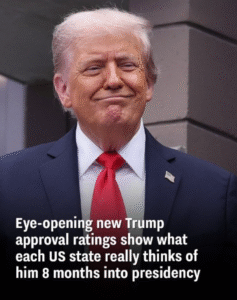
📊 Donald Trump’s Approval Ratings by State: A Nation Divided Eight Months Into His Second Term
Eight months into his second term as President of the United States, Donald Trump’s approval ratings paint a complex and deeply polarized picture of the American electorate. While he continues to enjoy strong support in many traditionally conservative states, his national approval remains below average, and several swing states have turned against him. The latest data from Morning Consult and Gallup reveal a country split not just by party, but by geography, demographics, and political priorities.
🇺🇸 National Overview: A Lukewarm Reception
As of September 2025, Trump’s national approval rating hovers around 40–45%, with disapproval at 52–56%, depending on the polling source. These numbers place him below the historical average for presidents at this stage in their term. For comparison:
- Barack Obama had 53% approval in September 2009.
- George W. Bush stood at 56% in 2001.
- Ronald Reagan enjoyed 60% in 1981.
- Trump’s own first term averaged 41%, and his current second-term average is 42%.
Despite the low national numbers, Trump retains near-total loyalty among Republicans, with 93% approval, while only 35% of independents and 1% of Democrats support him.
🗺️ State-by-State Breakdown: Where Trump Stands Tall—and Where He Falters
🔴 Strongholds: Trump’s Top States
Trump enjoys net-positive approval ratings in 25 states, down from 27 in August. His strongest support comes from deep-red states:
| State | Approval | Disapproval |
|---|---|---|
| Wyoming | 62% | 33% |
| Idaho | 60% | 37% |
| West Virginia | 60% | 37% |
| South Dakota | 58% | 38% |
| Tennessee | 58% | 38% |
| Oklahoma | 63% | 34% |
| Alabama | 62% | 35% |
| Arkansas | 61% | 37% |
| Kentucky | 59% | 38% |
| Indiana | 57% | 40% |
These states consistently rank among the most conservative in the country and have remained loyal to Trump throughout both terms.
🟡 Battlegrounds: The Swing States
The swing states tell a more nuanced story. Of the key battlegrounds from the 2024 election:
- Georgia remains the only swing state with net-positive approval for Trump (46% approve, 44% disapprove).
- Arizona sits at a dead-even split (50% approve, 50% disapprove).
- North Carolina and Nevada have flipped to net-negative approval since August.
This shift could have major implications for the 2026 midterms and the broader Republican strategy.
🔵 Blue Wall: States Where Trump Is Deeply Unpopular
Trump’s lowest ratings come from traditionally Democratic states:
| State | Approval | Disapproval |
|---|---|---|
| Vermont | 26% | 71% |
| Hawaii | 28% | 69% |
| Maryland | 30% | 67% |
| Massachusetts | 32% | 66% |
| California | 33% | 64% |
| Washington | 36% | 61% |
| Oregon | 37% | 61% |
| Illinois | 37% | 61% |
| New York | 38% | 59% |
| New Jersey | 40% | 58% |
These states have consistently opposed Trump’s policies, especially on immigration, climate, and social issues.
🔍 What’s Driving the Numbers?
🏛️ Policy Decisions
Trump’s second term has been marked by controversial executive actions:
- 202 Executive Orders signed in eight months, including:
- Renaming the Gulf of Mexico to the “Gulf of America”
- Banning transgender athletes from female sports categories
- Creating a task force for America’s 250th Independence anniversary
- Aggressive immigration enforcement has led to protests in cities like Los Angeles.
- Tariff changes and trade disputes have unsettled markets and voters.
These moves have energized his base but alienated moderates and progressives.
💰 Economic Sentiment
Trump’s promise of economic revival has yet to materialize:
- Inflation remains stubbornly high.
- Trade wars have disrupted supply chains.
- Job growth has slowed compared to early 2024.
Approval of Trump’s handling of the economy has dropped sharply since January, especially among independents.
🧠 Cultural and Partisan Divide
The partisan gap in Trump’s approval is the largest in modern history:
- Republicans: 93% approval
- Democrats: 1% approval
- Independents: 35% approval
This divide reflects broader cultural tensions, with Trump’s rhetoric and policies often polarizing rather than unifying.
🧭 Trends Over Time
Trump’s approval peaked at 47% in January 2025, shortly after his inauguration, but dropped to 37% in July, following controversies around the Epstein case and immigration raids.
His approval has remained relatively stable since then, but the loss of support in swing states like North Carolina and Nevada suggests a downward trend.
🗳️ Implications for the Future
With midterm elections looming in 2026, Trump’s approval ratings could shape the political landscape:
- Republicans may struggle in swing states where Trump’s numbers have declined.
- Democrats are likely to target states like Arizona, Pennsylvania, and Michigan.
- Independent voters will be key, especially in states with near-even splits.
Trump’s ability to maintain control of the Republican base is unquestioned, but his broader appeal remains limited.
🧠 So What Does It All Mean?
Trump’s second term is unfolding in a deeply divided America. His approval ratings reflect a nation split by ideology, geography, and experience. While he remains a dominant force in conservative strongholds, his national standing is weaker than any modern president at this stage.
Whether this will translate into political vulnerability or continued resilience depends on how the next year unfolds—and how voters respond to the policies, rhetoric, and realities of Trump’s leadership.


